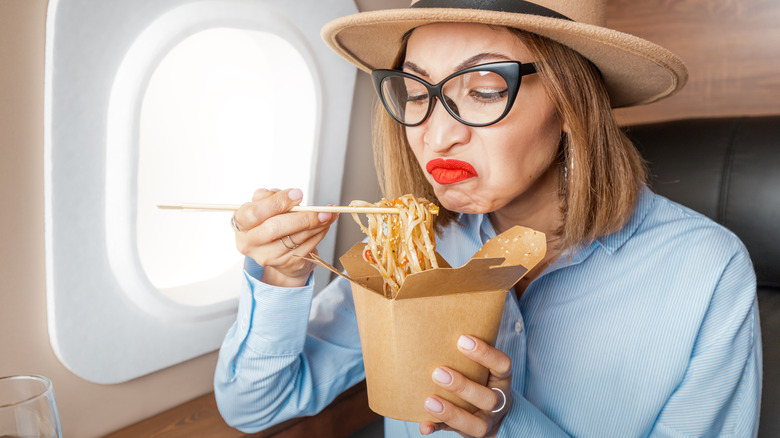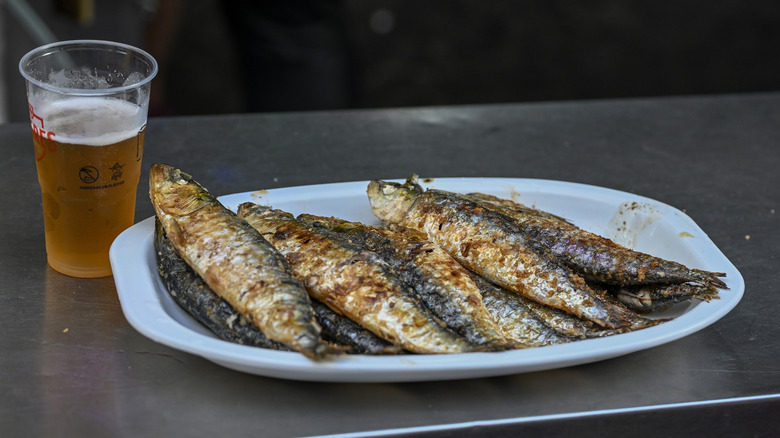The Unspoken Etiquette For Eating Hot Food On An Airplane
Unless you're flying business class (or maybe economy on a long-distance flight), it's pretty rare for airlines to give passengers anything to eat these days without paying extra. On a domestic flight, you might be lucky to get a one-ounce package of pretzels and a cup of coffee, but for the most part, you'll be getting your credit card out for anything more substantial.
And, perhaps because of the captive audience, airline food can be overpriced, and you'll have to wait until mid-flight to be served. So it's little wonder that travelers increasingly want to bring their own food on board. But, there's some unspoken etiquette rules around what you should pack to bring on an airplane and what you shouldn't bring on board. Most cold foods, like salads, sandwiches, and packaged snacks, are typically fine since they tend not to have strong smells.
Freshly-cooked hot food, on the other hand, is often less welcome because its smell carries and you may be subjecting the whole cabin to the scent of a burger. For this reason, the best etiquette is to fully avoid bringing hot food onto the plane. In fact, some airlines (including several budget airlines in Europe) ban it altogether. Flying is stressful enough without the secondhand smell of your row mate's fish soup.
Some hot foods are worse than others
While it's most polite to just not bring any hot food onto a plane, it's hard to avoid when you're hungry, have a long flight, and are presented with food takeout options in the terminal.
If this situation arises, it's best to consider a less-pungent hot meal to bring on board, if at all possible, since not all hot foods have the same level of odor. Greasy fast food tends to have a distinctive and slightly rancid smell, so it's ideal to skip burgers and fries.
Fish and eggs are other big ones to avoid; this extends to cold fish, too — nobody wants to be trapped in a metal tube that smells of tinned tuna. Otherwise, consider if the meal you're bringing on board has other more intensely-scented ingredients, like garlic, onion, or blue cheese. Some other veggies like Brussels sprouts and broccoli also have an intense smell, too, and should be avoided. If you can skip unwrapping these sorts of ingredients, you're less likely to feel the wrath of other passengers around you in the aircraft.
What to bring when you want to eat on a flight
It may seem obvious, but if you want a hot meal while traveling, try to fit it in before you get on the plane. Airport food will generally be better than airline food, anyway, since eateries in the terminal will often have access to a full kitchen in which to prepare meals — and you'll have a wider variety of menu choices. Plus, you'll be able to enjoy your meal with more space and a better environment since you taste food differently while flying due to the dry air in a plane cabin that dulls your sense of taste.
If you arrive at the airport without much time to spare before your flight, you may not want to risk missing your departure to eat a full meal. So try to eat it on-the-go or chow it down quickly when you first board the aircraft, as other passengers file in, so that your meal is not as intrusive. Ideally, though, the best idea is to grab something cold or shelf-stable. Pretty much every airport has at least one kiosk or storefront with a grab-and-go refrigerator of sandwiches and salads, as well as packaged chips, nuts, granola bars, and more. So you can keep it simple and just grab something from those spots — your fellow passengers will thank you.



